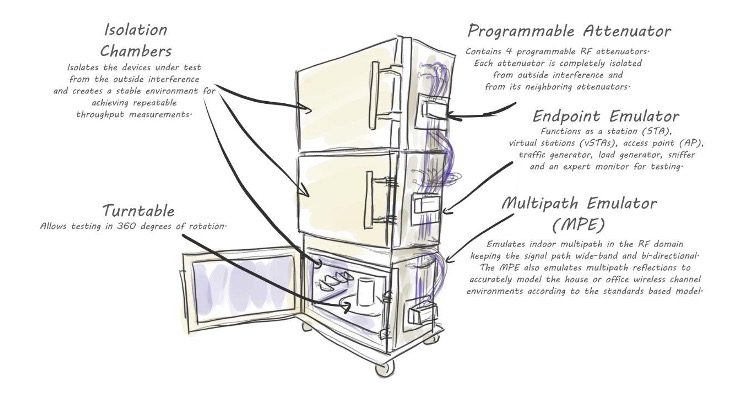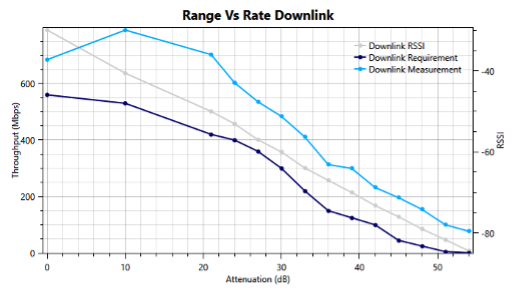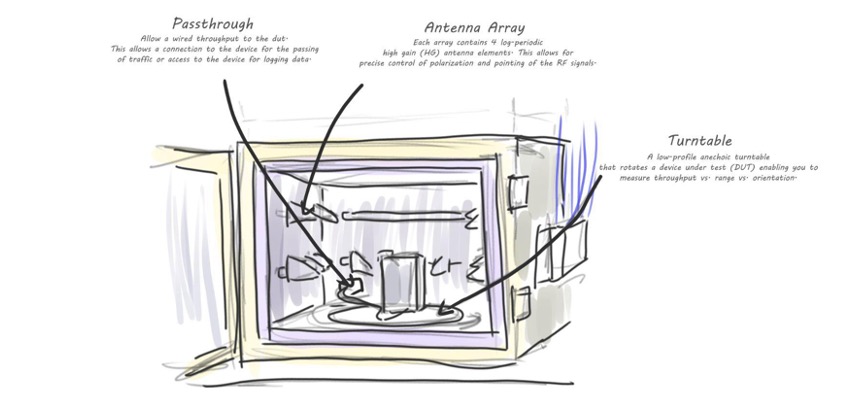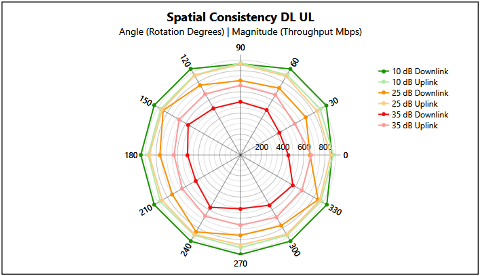To ensure that a device facilitates as intended for use, two main performance tests are conducted: RvR covers the performance in terms of distance, while Spatial Consistency covers the performance in terms of rotation. While these tests are not exhaustive, they play a significant role in guaranteeing a good user experience.
Wi-Fi is ubiquitous, and its application space is expanding rapidly, with an estimated 29.3 billion networked devices in 20231. As the usage of Wi-Fi products increases, reliability, bandwidth, network, and device performance become critical factors for product manufacturers. These factors, along with others, contribute to the end-user's experience. Suppose a production line goes down because of a lost industrial automation connectivity or a home security device stops sending updates due to a moved location. In that case, it can cause dissatisfaction among customers. However, wireless testing is a reliable way to ensure that devices perform as expected by putting them through repeatable scenarios. Let's take a closer look at two wireless tests, Range vs Rate (RvR) and Spatial Consistency, that help to ensure that devices can perform well in an increasingly connected world.
The RvR test evaluates the performance of an Access Point (AP) or Station (STA) in terms of distance. The main idea behind RvR is to test the throughput by starting at a close distance and then gradually increasing the steps/distance until the point where the traffic fails to pass. This kind of testing is familiar in data communications, and RvR has been used in many point-to-point technologies.
When it comes to testing Wi-Fi devices, certain challenges arise due to the wireless nature of the technology. Unlike traditional wired connections, Wi-Fi uses radio waves to transmit data over the air. All the Wi-Fi devices use the same air space as a shared medium. For this reason, testing a Wi-Fi device in "open" air becomes a challenge and almost impossible. Other wireless devices can also interfere with testing and impact results. For consistent and reliable results, an isolated testing environment is necessary to eliminate external interference and perform accurate testing.

Figure 1: Spirent OCTOBOX Testing Equipment
The test setup uses programmable attenuators between smaller wireless isolation chambers. The attenuators add attenuation to the radio frequency (RF) signal and accurately emulate the distance at each test step, allowing for repeatable and precise measurements. Within each chamber, near field antennas provide an RF patch between the device under test (DUT), the attenuator, and next chamber. This approach has an advantage over purely conductive testing, which excludes any impacts from the DUT’s antenna design, placement, or similar factors. This test can be conducted for differing 802.11 standards with varying settings.
The final results of the test provide an acute depiction of the device's performance with respect to the distance from the other endpoint. You can see the distance at which the device can still provide adequate throughput. This is valuable information for both the end user and manufacturers.

Figure 2: Range vs Rate Downlink
Wireless testing presents a unique challenge, unlike wired end-to-end testing, as it involves endpoints that are separated not only by distance but also in different directions. This means an STA can move around an AP, changing orientation with respect to each other. The Spatial Consistency test evaluates the performance of the dimension of rotation. Minimal variance in performance across rotations is expected. However, high variance in performance across rotations could result in poor user experience, depending on the orientation of wireless equipment. If you are at the same distance from the AP and rotating around it, you would want to maintain your connection and experience degraded performance.

Figure 3: Spirent OCTOBOX with Antenna Array and Turntable
To simulate this scenario in testing, a turntable rotates the device under test and measures performance at each rotation increment. We use wireless isolation chambers along with directional antennas to keep results accurate. Antenna placement is important and plays a significant role in spatial consistency. We have helped identify devices with "dead zones" and seen design changes to the devices that move components around that had been impeding the wireless signal at certain angles. The value of this test is evident to the end user, as the device is reliable even when rotated or moved around, and the device maintains its connection.

Figure 4: Spatial Consistency DL UL
Testing of Wi-Fi devices is crucial for both end users and manufacturers. Users expect their devices to be consistent and reliable, regardless of their location or orientation to the AP. Adding Wi-Fi to a device is not trivial; it requires careful planning, testing, and sometimes even redesign.
While these tests are not exhaustive, they play a significant role in guaranteeing a good user experience. Apart from these tests, other tests are also conducted for other use cases. Nevertheless, these two basic performance tests have a crucial impact on device manufacturers, both APs and STAs. It's essential for device manufacturers to build an excellent reputation that provides users with an outstanding user experience that resonates. By delivering exceptional user experiences, manufacturers can confidently stand out from the competition.
IOL has been testing Wi-Fi devices since 1996 and is an approved testing laboratory by the Broadband Forum to offer BBF.398 Carrier-Grade Wi-Fi testing services. Learn more about other Broadband Forum testing at UNH-IOL, including Wi-Fi 398, PON, USP TR-369, and more on our testing services page.
